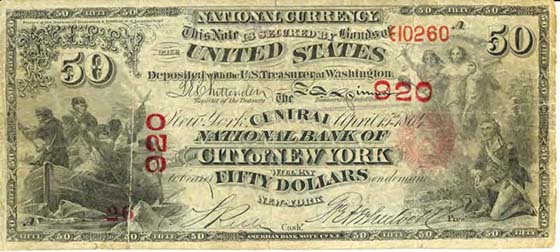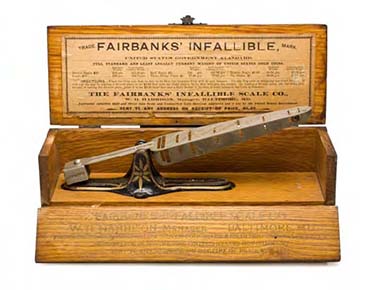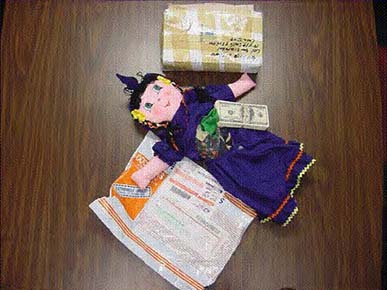April 15, 2010 – Funny Money – The Fight of the United States Secret Service against Counterfeit Money, that is the title of the new exhibition of the American Numismatic Society and the United State Secret Service at the Federal Reserve Bank of New York.
Counterfeit $50 national currency note, first charter period, issued by the Central National Bank of New York City, 1864 (one side copy). Courtesy of the USSS.
Counterfeiting money is one of the most common financial crimes in the history of mankind. Often punished severely, it nevertheless continues to the present day. Organized by the American Numismatic Society, the Federal Reserve Bank and the United States Secret Service, the exhibition gives a unique insight in the workings of the Secret Service in their fight against counterfeiters. Better known today for its protection of the US President, the Secret Service was originally set up in 1865 to combat and prevent counterfeiting.
The material in the exhibition, most of which has never been displayed before, illustrates the work of one of the more mysterious government agencies, which has rarely made its operations as public as in this exhibition.
In the 1860s, over one third of all circulating currency was estimated to be counterfeit, which presented a serious threat to the economy. Within the first two decades, the Secret Service established routines for investigating counterfeiters and bring them to justice. Newspaper reports from the period paint a vivid picture of a culture in which counterfeiters were both vilified for their crimes while being admired for their skills in producing and passing counterfeit money.
Portrait of William Brockway.
Famous counterfeiters, such as William Brockway – read the original article in the New York Times on his trial in 1896 – and Victor Lustig – see the Wikipedia article on the seller of the Eiffel tower, were very famous in their days, and the press reported their various activities in great detail. Whereas traditionally men are convicted of counterfeiting, the material shows the involvement in these operations of women, who were employed to pass fake money, supervise work or finance the purchase of equipment.
The exhibition introduces the various techniques employed by counterfeiters. Until the advent of the computer and ink-jet printers, counterfeit notes were made with engraved plates on offset printing machines. Nowadays, counterfeiters often use a home-office set up to produce small badges of counterfeit money. The exhibition features a note made by Albert Talton – more about the inkjet counterfeiter, who was arrested in California in 2007 in one of the largest and best organized counterfeit rings. He and his team produced millions of counterfeit dollars by using equipment and supply from Staples.
US Fairbanks coin counterfeit detector scale with balance peg, salesman sample kit with wood presentation box & pricing info. McNally/Harrison design patent. February 28, 1882. Design # 12,795. In light of the large number of counterfeit coins in circulation, coin counterfeit scales were popular. Courtesy of ANS. Gift of Anthony Terranova.
Thanks to the help of several retired US Secret Service agents, the exhibition is able to shed light on an investigation of the largest counterfeit ring in US history, during which 85 people were arrested in the late 1980s in Queens, New York; the gang produced $100 million of counterfeit money, which was connected to a Colombian drug operation. Surveillance photos, mugshots and other records show the painstaking work of the special agents over several years. Other parts of the exhibition illustrate the techniques of counterfeiters to produce counterfeit money as well as the new techniques of using scanners and inkjet printers. The Secret Service’s operations in South America and abroad are also well illustrated, where counterfeit money often plays part in the trade of drugs and arms.
Photo of doll, which is stuffed with counterfeit money.
The curator of the exhibition, Dr. Ute Wartenberg Kagan, explained how the exhibition looks at the people and what motivates them in their work, both as criminals and special agents. “Many of the counterfeiters through the ages are motivated by greed, but in almost all the stories there is an element of pride in producing a good product. On the other hand, the investigative work of the Special Agents is so much less glamorous and gets little attention. Through the exhibition you can see how some agents follow certain criminals for years, and a relationship develops. When putting together the exhibition from the photos, reports, newspaper clippings, surveillance and arrest photos, I got to know some of these criminals or Special Agents quite well, and I hope that Funny Money conveys some of this atmosphere to the visitors of the exhibition.”
The exhibition will run from 9 April until 31 December 2010.








